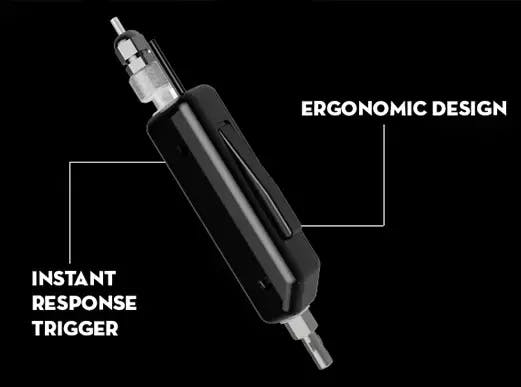Handheld Remote Reduces Material Waste and Scrap
At the heart of Designetics’ semi-automated fluid application systems is the 6000 Handheld Remote, which interfaces with the e3mini or e3multi precision pump panel to provide fluid to the applicator. The user simply activates the remote via a trigger, and a pneumatic switch provides a signal to the pump panel to begin dispensing.
By using a pneumatic (rather than electrical) switch for the trigger of the Handheld Remote, a potential spark hazard has been eliminated.
The trigger of the Handheld Remote has an instant response, so there is no delay at the start or end of application, allowing the system to deliver a consistent, accurate flow of fluid throughout the process. And by pairing the Handheld Remote with the e3mini or e3multi pump panel, operators can “dial in,” or optimize, the feed rate of fluid, for better quality control and less waste. The semi-automated system also significantly reduces material scrap due to improper application or fluid drips.

Semi-automated fluid application systems using Designetics’ 6000 Handheld Remote speed up production processes without compromising quality.
Semi-Automated Systems Provide Consistent Fluid Flow
For a given fluid and substrate, there are two main variables that determine the quality of fluid application: feed rate and speed. Feed rate refers to how quickly the fluid is delivered to the applicator, and speed refers to how fast the applicator moves against the substrate. During manual fluid application, both parameters are variable, controlled directly by the operator’s movements – squeezing the bottle to deliver fluid to the applicator (feed rate) and moving the applicator by hand to apply the fluid to the substrate (speed).
Because semi-automated fluid application systems rely on the pump panel – triggered by the remote – to deliver fluid to the applicator, the feed rate is perfectly consistent. Eliminating the variability of the feed rate means there’s less variance in fluid application by a single operator over the course of a shift or over multiple shifts. And even variances in application between different operators are significantly reduced.
The trigger of the 6000 Handheld Remote is ergonomically designed, so there’s less fatigue and stress on the operator, both of which are problems often experienced in manual fluid application systems, due to the operator squeezing an applicator bottle for prolonged periods of time. And for hard-to-reach fluid applications, the 6000 Handheld Remote can be configured with the applicator adaptor in-line with the remote (and with the incoming material tube), or with the adaptor at a 45 degree angle to the remote.

A magnetic docking station is provided with the Handheld Remote, giving the operator an easy way to store the remote and keep the applicator moist when not in use.
Making the Transition from Manual, to Semi-Automated, to Fully Automated Fluid Application
Moving from a manual to a semi-automated fluid application system not only helps manufacturers improve their internal processes, it also makes the transition to a fully automated fluid application system easier, because some of the investment in equipment and training has already been made with the semi-automated system. And manufacturers who implement a semi-automated system first and prove its effectiveness in reducing cost, improving quality, and increasing throughput, find that employees, managers, and other stakeholders are more supportive of the move to a fully automated system when the time comes.
Whether you have five employees or five hundred, it’s very likely that your fluid application process could benefit from some level of automation. If you’d like to explore the potential for automation in your process, reach out to us. Designetics’ engineers can help you determine if taking the step from manual to semi-automated fluid application is right for your operation.
